China’s emissions, efficiency targets under threat after falling short in 2023

Bloc commits to mobilize $10.8bn for ASEAN sustainable projects SINGAPORE, March 12 (Reuters) – China is falling short on key targets for tackling climate-warming emissions, and analysts said Beijing’s credibility in global climate talks could be at risk unless it redoubles its efforts to get back on track. The Chinese government has rarely missed targets in the past. But now, driven primarily by energy security concerns, it has shown little political will to address the emissions gap, analysts said. China’s National Development and Reform Commission (NDRC), a planning agency, promised last week to “redouble efforts in energy conservation and carbon reduction” this year after it “fell short of expectations” in 2023. Analysts say it is well behind on its goal to slash energy intensity by 13.5% and carbon intensity by 18% between 2021 and 2025. The intensity rates – measuring how much energy is consumed and how much carbon dioxide emitted per unit of economic growth – are a key part of the country’s pledge to bring emissions to a peak before 2030 and to net zero by 2060. Keeping its targets within reach would require “concerted efforts across all sectors to bridge the gap”, said Jom Madan, senior research analyst with the consultancy Wood Mackenzie. But the planning commission set targets for 2024 that fall far short of what is needed. For energy intensity, the commission mandated only a 2.5% reduction. It set no new target for carbon intensity, and made no new moves to curb the use of coal – the most polluting fossil fuel. Madan predicted that China might “come close … but not quite achieve its targets” on energy efficiency. If the country misses its 2025 targets, it could raise doubts worldwide about its ability to rein in emissions. The country also risks a “serious loss of diplomatic credibility,” said lead analyst Lauri Myllyvirta of the Centre for Research on Energy and Clean Air. “China has long emphasised its ability to implement the country’s commitments, while criticising others for setting lofty targets,” he said. The NDRC did not respond to a request for comment. As the world’s biggest carbon polluter and second-largest economy, China has faced growing international pressure to show more climate ambition. It has resisted, arguing that it is already doing more than most fast-developing countries. China’s rising emissions account for 35% of the world’s annual total. On a per capita basis, the emissions level is 15% higher per capita than the OECD average, the International Energy Agency said last week. To meet its goals, Beijing should focus on efficiency improvements in industry and construction, and offer more financial support for companies to replace or retrofit outdated facilities, Madan said. Expanding the carbon market would also help, he added. NEW REALITY Officially, China’s energy intensity fell 0.5% in 2023, the country’s statistics bureau said last month, missing a 2% target. The gap would have been worse, but China last month removed non-fossil fuels such as nuclear and renewable energy from the equation to focus on tackling fossil fuels. China is applying this definition retroactively, Myllyvirta said. Without the change, the energy intensity calculation would have shown an increase of 0.5%. Myllyvirta estimated that China would need to cut energy intensity by 6% in 2024 and 2025 to meet the 2021-2025 target – far higher than the 2.5% goal set this week. Energy intensity might matter less in the future, however, said Ma Jun, director of the Beijing-based Institute of Public and Environmental Affairs. The change in how it is calculated “reflects a new reality” for China, in which economic growth is increasingly driven by the renewables sector, and fossil-fuel dependent industries will come under more pressure to boost efficiency, Ma said. “That means carbon intensity is going to matter more,” he said. Although China set no new targets for carbon intensity, the country’s economic growth implies the measure will fall about 3% this year, analysts said. However, after dropping 4.6% from 2020 to 2023, carbon intensity would need to drop about 7% this year and next to reach the 2025 goal, Myllyvirta said. Missing climate targets is unusual for China, which has made job promotions contingent on environmental progress to encourage workers and agencies to meet goals. In 2022, China’s corruption watchdog warned that some regions were providing fraudulent energy and carbon intensity figures that were overly positive. Pressure to comply with intensity targets also caused economic disruptions in 2010, with provinces cutting power supplies to energy-intensive industries and forcing homes to ration electricity. Without a major boost to its climate efforts now, “meeting the five-year intensity targets by 2025 will be very challenging,” said Li Shuo, director of the China Climate Hub at the Asia Society Policy Institute in Washington. “This year’s government work report certainly did not signal that level of decisiveness,” Shou said.
Abang Rahmat Yusuf is CEO of Sarawak Sovereign Wealth Future Fund
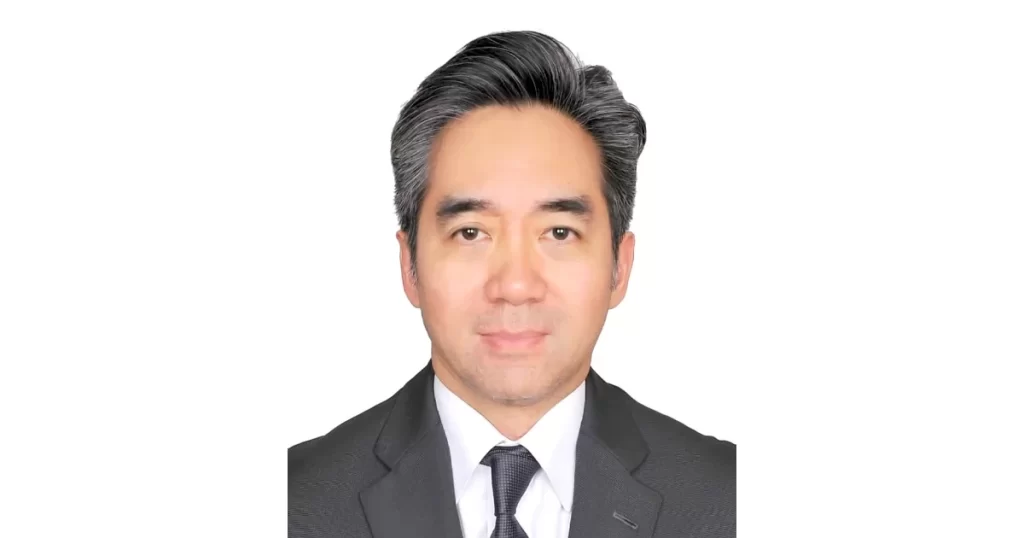
KUCHING: The Board of Guardians of the Sarawak Sovereign Wealth Future Fund has appointed Abang Rahmat Yusuf as the Chief Executive Officer (CEO), effective January 29 this year. The announcement was made after the Board meeting yesterday, according to a press statement. Abang Rahmat, 48, was formerly the head of Investment Banking (Malaysia) at CLSA Securities from 2019 to 2024. During his tenure there, he led the fund raising exercises including initial public offerings (IPOs) and placements for institutional and corporate clients. In the beginning of his corporate career, he was a director in the Investments arm at Khazanah Nasional in 2004 until 2019, during which he established and headed the Khazanah Turkey Regional Office in Istanbul covering Turkey, Middle East and North Africa (MENA) and Sub-Saharan Africa. He was also the Overseeing Director for Financial Institutions Group (FIG), which represented 20 per cent of Khazanah’s portfolio. He holds a Master in Public Administration from Harvard University.
Germany launches green subsidies for industry

Bloc commits to mobilize $10.8bn for ASEAN sustainable projects BERLIN, March 12 (Reuters) – Germany on Tuesday launched a bidding process for subsidies to support energy-intensive firms switching to green production in a 4 billion euros ($4.37 billion) funding round, the economy ministry said on Tuesday. As part of Germany’s ambitions to become climate-neutral by 2045, Berlin plans to award companies in sectors such as steel, glass, paper and chemicals 15-year subsidies in return for reducing carbon emissions in production. The European Commission has approved the instrument where companies will be selected through a bidding process while competing over cutting emissions at the lowest cost. Through the so-called climate protection contracts, companies will be compensated for the extra costs of green production in industries where climate-friendly production processes cannot currently operate competitively. “Today is a good day for Germany as an industrial location, for climate protection and for sustainable jobs in our country,” said Economy Minister Robert Habeck. Berlin had originally planned to offer subsidies up to a mid double-digit billion euro sum, but the programme was put at risk by last year’s constitutional court ruling stopping the government from using some 60 billion euros of debt for climate protection projects. ($1 = 0.9148 euros)
Bintulu’s Samalaju Industrial Park nets RM111.73b approved investment since 2008 launch, says Sarawak premier

BINTULU, March 5 — Premier Tan Sri Abang Johari Openg said last night that Samalaju Industrial Park, which was launched by the then prime minister Tun Abdul Ahmad Badawi in 2008, has attracted an approved investment of RM111.73 billion to date. He said RM12.07 billion out of the total has gone towards commercial production, with direct employment for 9,293 workers. “The potential is there. We have a list of companies which are going to invest in the park, with an anticipated investment of RM15.66 billion,” he said during the 10th anniversary of Sakura Ferroalloys Sdn Bhd. He said there are also a few projects that are being enhanced, one of which is the 70km-long Bintulu-Samalaju gas pipeline that is scheduled for completion at the end of next year. “The operations of these projects will increase the distribution of gas supply to users in Samalaju Industrial Park including the combined cycle gas turbine which is currently under construction. “In other words, we are upgrading the gas supply as well as power to Samalaju Industrial Park,” he said. In his speech earlier, Sakura Ferroalloys Sdn Bhd chairman BH (Tiaan) van Aswegen said the company is in the process of constructing a new sinter plant at the site. “This US$30 million plant will be commissioned in the second half of 2024 and will contribute to further improve plant efficiencies and lower the cost base,” he said. He said a feasibility study to produce a value-added refined ferro-manganese product will be concluded by mid-year. “If the study results are positive, this might lead to a further investment of around US$100 million at Sakura,” he said, adding that studies to produce by-products from current waste streams, such as slag, fumes and gas, are being pursued.
EU official praises green energy push by Malaysia’s Sarawak

Bloc commits to mobilize $10.8bn for ASEAN sustainable projects Six major ports function as crucial transhipment hubs that play integral roles in the state’s supply chain by NURUL SUHAIDI KUCHING, Malaysia — Sarawak, a resource-rich state in Malaysia with an ambitioussustainable energy agenda, is drawing interest from the European Union, but the 27-nation group’s top official in the country says the bloc needs new cooperativemechanisms for its companies to take advantage of the opportunity. “We have seen the opportunities and the vision of the state, bringing in hydrogen,sustainable transition to green energy and energy transition,” Michalis Rokas, the EUambassador to Malaysia, said in a speech at the EU-Malaysia Business Day 2024 eventheld on Feb. 14 in Kuching, the capital of Sarawak, which is located on the island ofBorneo.Malaysia is the EU’s third largest trading partner in ASEAN, while the EU is the fourthlargest destination for Malaysian exports. The EU is also the second largest source offoreign direct investment for Malaysia at 25.2 billion euros in 2022. Still, Rokas acknowledged the limited presence of European businesses in Sarawak. Tobridge this gap, he proposed a “blending” model whereby European companies wouldtake the lead in strategic investments, while the EU would provide financial supportthrough grants, guarantees and concessional loans through the European InvestmentBank (EIB). This approach aims to de-risk projects and attract private capital,accelerating Sarawak’s green ambitions.Rokas also said the potential partnership aligns with the EU’s Indo-Pacific Strategy,which emphasizes fostering partnerships with regional countries on issues like climatechange and clean energy. Sarawak’s focus on developing hydrogen production,sustainable aviation fuel, and transitioning away from fossil fuels resonates with theEU’s own sustainability goals. The EIB has been active in Southeast Asia for over three decades, financing projects invarious sectors such as energy, transport, climate action and infrastructure. In 2022, itopened a regional representative office in Jakarta to further strengthen its engagementin Indonesia, Vietnam, Cambodia, Laos and the Philippines. Nikkei Asia understandsthat the bank has been attempting to operate in Malaysia since 2020. Its application ispending government approval for a framework agreement.Rokas also said during his speech that the EU and its 15 member states with a presencein Malaysia will be working on a plan to propose a Global Gateway flagship project inSarawak.Meanwhile, the state’s deputy premier Awang Tengah Ali Hassan welcomed thepotential partnership, highlighting the existing trade relationship between Sarawak andthe EU, which stood at 2.1 billion euros in 2022. He emphasized the state’s commitmentto renewable energy, with a target of generating at least 60% of its power from cleansources by 2030. Sarawak, abundant in oil, gas and timber, is the only Malaysian state with more than70% renewables in its energy mix, mainly from hydroelectric dams. It has threeoperational large-scale hydroelectric dams, with a fourth, Baleh, under construction.The total installed capacity of the operational large-scale hydroelectric dams in Sarawakis 3,452 megawatts. Once Baleh is completed, the total capacity will increase to 4,737MW.Last year, Sarawak announced plans to sell one gigawatt of renewable energy toSingapore via a 700km undersea cable by 2032.“We seek to establish a stronger connection between Sarawak and Europe,” Awang saidat the business event. “I hope this will serve as a venue to forming new networks andposing new paths which yield fruitful outcomes towards an inclusive economy.” Headded that Sarawak’s green push has led to collaborations with global players fromSouth Korea and Japan to develop the hydrogen industry in the state.Sarawak is already embarking on two major hydrogen production projects — withJapan’s Eneos and Sumitomo Corp. on one called H2ornbill, and South Korea’sSamsung Engineering, Posco and Lotte Chemical on another dubbed H2biscus — in theport town of Bintulu, where one of the world’s largest LNG complexes is located.The Sarawak state legislative assembly building and Sarawak River in Kuching, Malaysia. (Photo by Norman Goh)4/2/24, 2:01 PM EU official praises green energy push by Malaysia’s Sarawak – Nikkei Asiahttps://asia.nikkei.com/Business/Energy/EU-official-praises-green-energy-push-by-Malaysia-s-Sarawak 5/5Get our Asia daily briefing newslettersnewsletter@nikkeiasia.com RegisterThe two projects will have the potential to produce up to 238,000 tonnes of greenhydrogen annually, generating an estimated 2.4 billion ringgit to Sarawak’s grossdomestic product by 2030, according to Abang Johari, the state’s premier during hisannual new year address in January.Sarawak also boasts, according to the premier, ASEAN’s first integrated hydrogenproduction plant and refueling station, powering hydrogen buses in Kuching since 2018and a tram on a test basis beginning last year.Also, a third hyrdogen project is based in Rembus, near Kuching, for domestic use andis expected to be fully operational in 2025, according to state-linked company SEDCEnergy and the Sarawak Economic Planning Unit. On Monday, SEDC Energy signed anagreement with Gentari, a subsidiary Malaysia’s state energy conglomerate Petronas todevelop the Sarawak H2 Hub in Bintulu, according to a statement by Gentari.Total hydrogen industry investment in Sarawak is estimated to be worth at $4.2 billion,an SEDC Energy spokesperson told Nikkei Asia.Hydrogen produced in Sarawak is known as green hydrogen — produced via electrolysisand powered by renewable electricity from hydroelectric dams. Additionally, the state ispioneering the production of crude algae oil for sustainable aviation fuel usingmicroalgae.Timothy Ong, the chief executive of the newly established state investment promotionagency InvestSarawak said at a panel session that Sarawak is not only in competitionwith other regions of Malaysia, but with countries like Vietnam, Indonesia, Thailandand Singapore as well.“Although a lot of people come to Sarawak for renewable energy, I can comfortably tellyou today that we have more demand than available supply when it comes to renewableenergy,” Ong said. He added it is important for the state to understand that investmentbenefits must trickle down to the people of Sarawak and companies and not just remainin the hands of foreign or domestic investors.
Awang Tengah receives courtesy call from Kuwait petroleum firm delegation
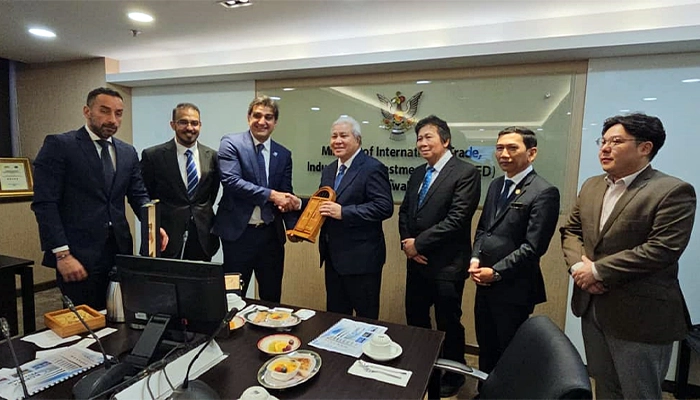
KUCHING (Jan 19): Deputy Premier Datuk Amar Awang Tengah Ali Hasan received a courtesy call from Kuwait Foreign Petroleum Exploration Company (KUFPEC) at his office in Wisma Sumber Alam here yesterday. According to a news release, the KUFPEC delegation was led by its country manager Mohamad Al-Sabti. Awang Tengah, who is International Trade, Industry and Investment Minister, chaired the meeting which was held to discuss investment opportunities between Sarawak and KUFPEC in oil and gas. Also present were Deputy International Trade, Industry and Investment Minister Datuk Dr Malcolm Mussen Lamoh and representatives from Petroleum Sarawak Berhad (Petros), Sarawak Energy Berhad and InvestSarawak.
Mark Carney sees ‘massive disconnect’ in green finance rhetoric
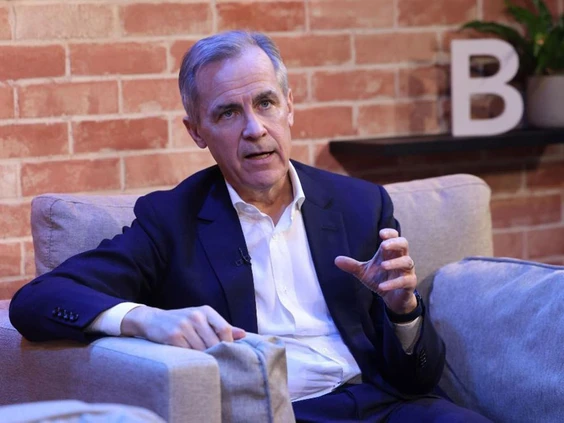
There’s plenty of money to be made by investing in the green energy transition, and financial professionals who say otherwise aren’t paying attention to the facts, according to Brookfield Asset Management Ltd. chair Mark Carney. There’s a “massive disconnect” between what some of the heavyweights of global finance are saying and the wave of money flowing into green projects, Carney, who’s a former governor of the Bank of Canada and Bank of England, said on Jan. 17 at the Bloomberg House in Davos, Switzerland. Article content Article content The comments follow a pivot in the messaging from bankers and asset managers, who have started using global summits to remind governments they’ll only back the green transition if there’s a profit to be made. It’s a mantra that’s being repeated at Davos. Speaking at a panel earlier on Wednesday, hedge fund billionaire and Bridgewater Associates founder Ray Dalio said “there’s this notion of ‘we should we should we should,’ but there’s the fact of who has the money, what is the size of it and what are their motivations.” Carney said that tracking green investment flows shows there’s enough motivation among the holders of capital to back the transition. In 2023, investors plowed 1.8 times as much into clean energy as they did into fossil fuels, according to the International Energy Agency. And the US$1.8 trillion that was spent globally on clean energy last year is expected to rise to US$4.5 trillion annually by the early 2030s, the IEA estimates. “That 1.8 trillion is going to make a very good returns,” Carney said. “Not every single investment, but the whole thing will make a very good investment elevator pitch.” Last year, many investors in traditional green assets lost money, as wind and solar producers were pummelled by higher interest rates. The S&P Global Clean Energy Index ended 2023 down more than 20 per cent, and has slipped a further 9.5 per cent in January. By comparison, the S&P 500 rose 24 per cent last year and is little changed so far in 2024. Carney said transition finance is an area in which investors stand to generate profits. “If you focus on going where the emissions are, you get paid for helping to solve climate change, and that’s now the reality,” he said. “You get paid more for doing that in the advanced world than you do in the developing, in emerging world, something we’ve got to fix with policy and finance, but because you get paid, you can do both: have a massive impact and, and make returns for your investors.” Carney, who served as governor of the Bank of England between 2013 and 2020, also commented on the U.K.’s green agenda, including a perceived retreat from climate policies by Prime Minister Rishi Sunak. “What I didn’t like — at least what it looked like to me — is that policies were being taken off the table without, certainly without replacements being put in and they were being done for purely political signalling purposes,” he said. “That’s what it appeared. And that isn’t the right environment to keep investment focused and flowing as much as it should. And it’s also, it’s just not good climate policy.” Article content Carney also touched on the outlook for the next few COP climate summits. What happens in Brazil, which will host the 30th Conference of the Parties to the United Nations Framework Convention on Climate Change in 2025, “is critical for the climate,” he said. Brazil’s ecological transformation plan “is significant in and of itself, but potentially very significant” in that “it can help create whole new financing flows around biodiversity, around nature at a scale that’s material,” he said. Carney also is United Nations Special Envoy for Climate Action and Finance and chair of Bloomberg Inc. Together with Michael R. Bloomberg, the founder of Bloomberg News parent Bloomberg LP, he co-chairs the Glasgow Financial Alliance for Net Zero.
Japan’s Sumitomo and Eneos toproduce green hydrogen in Malaysia

Hydroelectric-derived power will boost decarbonization drive TOKYO — Oil company Eneos and trading house Sumitomo Corp. will produce “green”hydrogen in Malaysia and export much of it to Japan under plans announced Monday,hoping to further diversify the supply of the fuel essential for decarbonization. The two Japanese companies have signed an agreement with SEDC Energy, a subsidiaryof the Sarawak Economic Development Corp. set up by the Malaysian state of Sarawak.They will also consider establishing a special-purpose company with the Malaysianpartner. Power from hydroelectric plants will be used to electrolyze water to produce the greenhydrogen without emitting carbon dioxide. The aim is to produce 90,000 tonnes a yearby 2030. The scale of investment will be finalized moving forward. SEDC Energy will take the lead on power procurement and hydrogen production, withEneos to provide technical support for the production. Eneos will also contributeproprietary technology for transporting the hydrogen by sea at room temperature.Sumitomo will evaluate project feasibility and financing. Hydrogen, which does not produce CO2 when burned, is essential for decarbonizationin such fields as power generation, transportation and manufacturing. But it isexpensive to produce in Japan, where renewable-energy costs are high. The Japanese government has set a goal of increasing the supply of hydrogen in Japanto 3 million tonnes per year by 2030, and Eneos and Sumitomo are working to produceand transport green hydrogen from around the world.
InvestSarawak dan Surbana Jurong tandatangani MoU perkukuh inisiatif ekonomi hijau
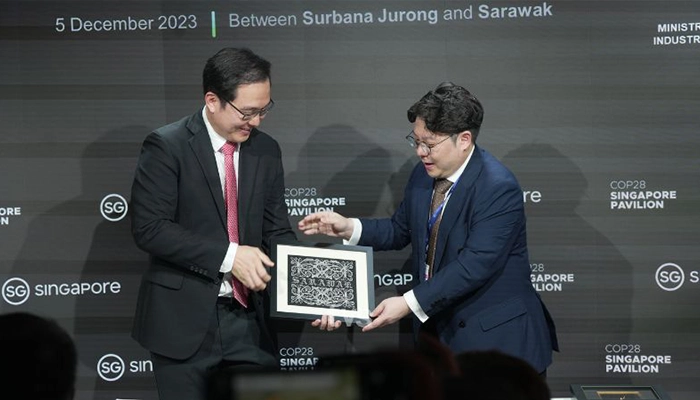
DUBAI, 5 Dis: InvestSarawak dan Surbana Jurong Infrastructure Pte Ltd menandatangani Memorandum Persefahaman (MoU) untuk memperkukuh inisiatif ekonomi hijau di Sarawak. MoU itu ditandatangani Ketua Eksekutif InvestSarawak, Timothy Ong Wye Ern dan Pengarah Urusan Surbana Jurong (Infrastruktur, Tenaga dan Industri) Tan Wooi Leong. Majlis yang berlangsung di Pavilion Singapura di Dubai semasa Persidangan Perubahan Iklim Pertubuhan Bangsa-Bangsa Bersatu (COP28) hari ini, disaksikan Premier Sarawak, Datuk Patinggi Tan Sri Abang Johari Tun Openg. “Daya tarikan Sarawak untuk pelaburan, khususnya dalam sektor yang mampan dan kolaborasi dalam sektor utama seperti pembuatan, pertanian komersial, pelancongan, perhutanan, perlombongan dan perkhidmatan harus ditekankan,” kata Abang Johari. Beliau turut menyatakan komitmen Sarawak untuk pertumbuhan ekonomi yang bertanggungjawab dan mampan, menggabungkan prinsip-prinsip Matlamat Pembangunan Sosial (SDG) dan Pemerintahan, Sosial, dan Alam Sekitar (ESG) ke dalam Strategi Pembangunan Pasca COVID-19 2030 (PCDS 2030). “Matlamat keseluruhan kita adalah untuk mempromosikan kemakmuran ekonomi, inklusiviti sosial dan kelestarian alam sekitar di rantau tersebut,” ujarnya. -TVS
Sarawak’s energy transition: Navigating the technological frontier for sustainable progress
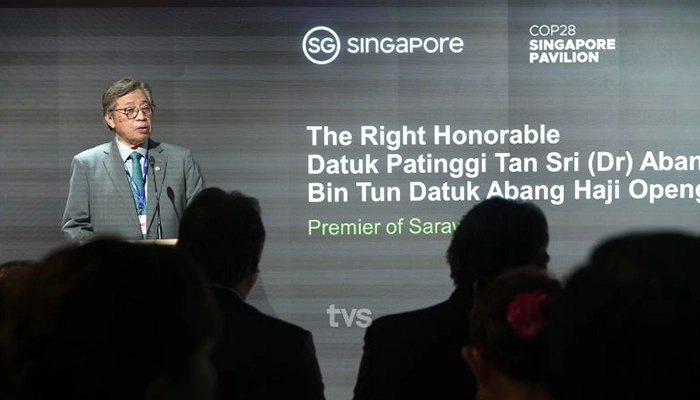
DUBAI, Dec 5: The synergy between technology and resources is crucial for Sarawak’s energy goals, emphasising the strategic utilisation of technological advancements and efficient resource management. Premier of Sarawak, Datuk Patinggi Tan Sri Abang Johari Tun Openg, emphasizes the significance of this transition as he highlights Sarawak’s technological aspirations focus on hydrogen production, a crucial component in the renewable energy landscape. “It’s a question of technology – harnessing the full spectrum of available resources. For instants three years ago, 1kg of hydrogen, requires 60kw of power. “But now we are working with Petronas, in doing our research, it can come down to 38kw,” he told this to reporter when visiting the Malaysian Pavilion after witnessing a Memorandum of Understanding between InvestSarawak and Surbana Jurong Pte Ltd in conjunction with the United Nation Climate Change Conference (COP28) in Dubai. This achievement is attributed to cutting-edge technology, particularly the incorporation of a new membrane in the electrolysis process. Abang Johari expresses optimism for significant cost reductions in hydrogen production over the next five years, anticipating a decrease in power costs. This move positions hydrogen as a more economical and environmentally friendly energy source. Sarawak’s commitment to incorporating hydrogen into its energy portfolio is evident in ongoing public transport initiatives within the region. “The conversion of H2O into hydrogen and oxygen is fueling public transport, with ongoing tests of Autonomous Rail Rapid Transit (ART) and buses powered by hydrogen,” he said. This transition to hydrogen-powered transportation not only signifies a significant step towards reducing carbon emissions but also underscores Sarawak’s commitment to embracing innovative solutions for a sustainable future. In tandem with technological advancements in hydrogen production, Sarawak is diversifying its energy sources. A pioneering approach involves the utilization of wood pallets as a biomass power source, adding a new dimension to Sarawak’s energy matrix and ensuring a diversified and resilient power supply. Abang Johari added that the state is actively involved in reforestation efforts, creating carbon sinks through the replanting of forests. This dual approach, combining technological innovation and environmental conservation, positions Sarawak at the forefront of sustainable energy transitions. – TVS

